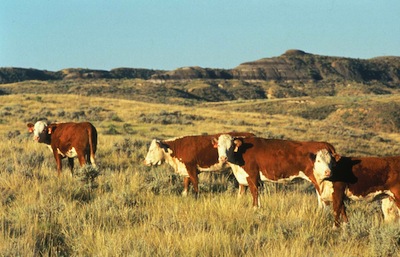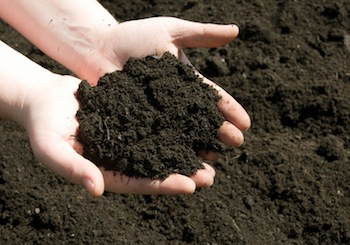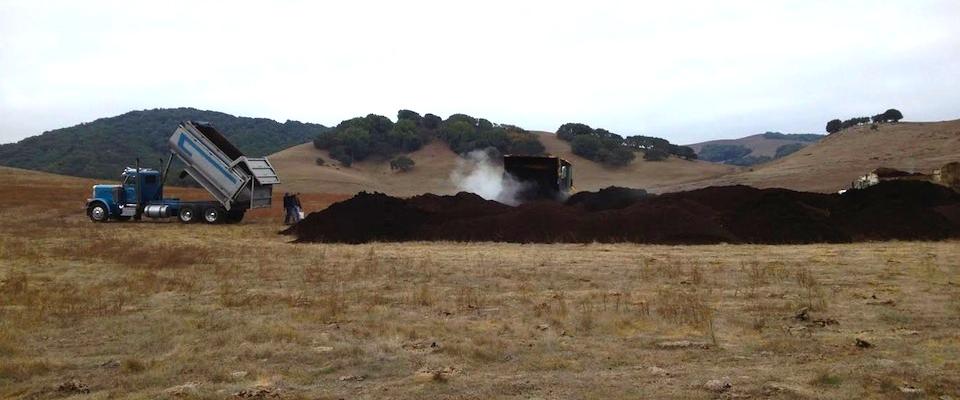New Global Warming Remedy: Turning Rangelands into Carbon-Sucking Vacuums
Studies conducted on a ranch in the heart of Marin County and led by UC Berkeley researchers and alums seem to confirm what home gardeners have long suspected: Compost really can save the world. That sounds hyperbolic, of course. But research led by Whendee Silver of Berkeley's Department of Environmental Science, Policy, and Management concludes that a judicious scattering of finished compost on our rangelands could lock up gigatons of atmospheric carbon, preventing it from heating up the planet and contributing to such unpleasantness as prolonged drought, polar ice cap loss, sea level rise and ocean acidification.
Apply less than an inch of compost to 5 percent of California's rangelands, and you suck enough carbon from the atmosphere to equal the emissions of 6 million cars.
What kind of numbers are we talking about? If a quarter-inch to one-half inch layer of compost were applied to 5 percent of California's rangelands, it would sequester 28 million tons of carbon from the atmosphere-the equivalent to the annual emissions of 6 million cars. That certainly sounds too good to be true. And yet, the published papers and support in the scientific community indicate that it's the real deal. "This is fantastic science with proven benefits," Paul Wright, director of UC Berkeley's Energy and Climate Institute, wrote in an email. "Not only for carbon reduction, but (for) soil quality, grazing land quality, and (soil) water retention." "It isn't just about stopping global warming," adds John Wick, the co-owner of Nicasio Native Grass Ranch, the site of the studies. "We can reverse it." Well, yes and no. Compost alone won't save the world. Our salvation also depends on civilization cutting back on fossil fuel consumption. It's not either/or. It's both/and. That said, a growing number of experts are coming to believe that composting rangelands could make a significant contribution. Wick says that the research grew out of concerns he and his wife, children's book author and illustrator (and Caldecott medalist) Peggy Rathmann, had about the state of the pastures on their 540-acre west Marin ranch. "When we bought the ranch, we were mainly interested in the natural beauty of the setting and the buildings that we intended to use for studios," says Wick. "We wanted things to be 'natural,' so we arrogantly (ended the lease) of a young man who was grazing cattle on our property." Within a relatively short time, however, Wick and Rathmann noticed that the bovine ban had an adverse effect. Their rangelands were degrading, not improving; invasive, non-indigenous grasses and forbs were replacing the native bunchgrasses and perennials. Further, the weeds were so thick that they were choking out brooding habitat for native ground-nesting birds. So the couple hired rangeland ecologist Jeff Creque, who holds a master's degree in range science from UC Berkeley, to look into the situation. Creque noted that California's grasslands had evolved with great herds of ungulates, tule elk among them. These herbivores would typically graze an area intensely, then move on. This pattern resulted in the periodic "harrowing" (with hooves) and fertilizing (with dung) of the land, encouraging the lush growth of native grasses. Creque suggested that Wick and Rathmann re-introduce cattle to their property, and manage them in ways that mimicked the feeding patterns of the long-vanished herds of elk that once cropped the Marin savannas.

"When we did, the changes were dramatic," Wick said. "We had native grasses and wildflowers coming back, and native birds were returning. You could just see our grasslands functioning at a higher state." But Creque wasn't thinking only in terms of cows and invasive weeds when he signed on with Wick and Rathmann. He had been deeply involved in organic farming for years-and organic farming, as its name indicates, is all about carbon. Soil carbon, specifically. To a large degree, soil productivity is linked to the amount of carbon it contains. Carbon improves the tilth and water retention capabilities of soil, and it is the central element in Soil Organic Matter, that component of dirt that contains all the biological residues and byproducts that make plants grow. The world's soils also are a massive sink for carbon, storing exponentially more carbon than persists in the atmosphere as CO2 along with more potent greenhouse gases such as methane and nitrous oxide. That's why Creque has long wondered: Can you jack up the carbon sequestration potential of rangelands? And if so, how? Compost seemed a promising avenue to Creque, but he wasn't sure about the best way to proceed. "John and I began talking about it, and he was very enthusiastic about using the ranch as a testbed," says Creque. "But we had to address a few basic questions. First, are there any protocols that will actually work? And if any do work, how do we measure their effects? Further, what is the market for rangeland carbon? Could we generate enough interest among rangeland managers to make a difference?" So Creque and Wick approached Silver, who's an authority on the chemical exchanges that occur among plants, soils and the atmosphere.
The revitalized rangelands turn into landscape-scale vacuum cleaners, sucking prodigious quantities of carbon-up to 3 tons per hectacre per year-from the air.
"Dr. Silver agreed to work with us, but she was highly dubious," recalls Creque. "She was by no means convinced that (carbon sequestration in soils could be significantly increased), and that it could be accurately measured if it did occur. That made her the perfect partner for us. Not only did she have the skill set we needed, but her skepticism assured that our research would be rigorously managed and the results thoroughly vetted." To get some baseline data, Silver led a study that compared soil carbon levels at 35 sites on beef cattle and dairy operations in Marin County. They found a range of carbon levels, but the sites that registered a lot of carbon had one thing in common: Ranchers and farmers had spread raw manure on the land. Those results were surprising, says Wick, because raw manure is known to emit prodigious quantities of greenhouse gases into the atmosphere. Yet somehow, carbon was getting down into the soil-and staying there. How did they know? "Dr. Silver sent out samples to have them carbon dated, Wick explains. In brief: Researchers use the rate of decay of a specific carbon isotope (Carbon-14) to determine the age of carbonaceous substances. In the case of the manured plots, researchers found traces of Carbon-14 linked to atmospheric releases of radioactive materials that occurred years ago; the isotopes were a meter deep. "That means carbon was being deeply sequestered in a stable form, and it was somehow due to the manure applications," Wick says. If raw manure is good, they figured, compost should be better: Its carbon generally is in more stable forms than that found in raw manure, and doesn't sublimate to the atmosphere as easily. So the researchers spread roughly a half-inch of compost on some test plots to see what would happen.

The results (confirmed by Silver) were pretty spectacular. Four years after application, 90 percent of the compost's carbon was still in the soil, says Creque. Further, the computer models the team developed indicated carbon levels would remain high for 30 to 100 years due to that single application of compost. But here's the best part: most of the carbon didn't come from the compost, it came from the atmosphere. The compost, it turned out, was a catalyst for a virtuous cycle. "By increasing soil carbon, you're increasing soil fertility and water retention capacity," Creque says. "That results in more robust vegetation, which captures more and more carbon from the atmosphere. This carbon is stored underground in the roots, in residual dry matter (on the surface) and in enhanced populations of microorganisms in the soil." Analyses of the composted plots indicated they were sequestering from one-half to three tons of carbon per hectare per year as a result of the single application, says Creque. The revitalized rangelands essentially turn into landscape-scale vacuum cleaners, sucking prodigious quantities of carbon from the atmosphere. That all looks good on paper (or pixels). But will it translate to the real world? Will farmers and ranchers -the people who will actually have to go through the laborious and sometimes aromatic process of spreading compost on their lands-take to it? Early indications are promising. Now functioning as the Marin Carbon Project, Wick, Creque and others, in conjunction with the Environmental Defense Fund and Terra Global Capital,have established protocols based on the research. Last month, The American Carbon Registry approved these procedures, meaning that ranchers who adhere to the protocols earn tradable carbon credits.
Why, then, isn't everybody jumping all over this? A methodology that can reverse runaway atmospheric carbon while churning out hamburgers is the planet's Golden Ticket.
Funding for the research and development of the protocols was provided the U.S. Department of Agriculture, the State Coastal Conservancy, and the 11th Hour Project, a program supported by the Schmidt Family Foundation Next step is a $20 million grant application pending before the USDA for the Bay Area, says Torri Estrada, policy director of the Marin Carbon Project and also a Cal alum who has lectured in the Department of Environmental Science, Policy, and Management. "And we're working with a number of county resource conservation districts-Marin, Sonoma, Mendocino, Santa Barbara, Napa, Tehama, Butte and Modoc-to help willing landowners implement the protocols." The protocols went through a rigorous vetting process with the American Carbon Registry, says Kyle Hemes, a program associate at the registry. That included a month-long public comment period and a blind peer-review process that involved multiple rounds of input from participants.

"The protocols were approved two weeks ago and are now up on our website," says Hemes. "Other projects are now free to use them to document greenhouse gas removals." The registry issues one credit for each ton of carbon that is sequestered. Right now, credits generated by the rangeland protocols can only be used for the "voluntary" carbon market. That's not necessarily a small exchange; firms like Google buy lots of voluntary carbon credits. But the so-called compliance market-dictated by legislation such as the California Global Warming Solutions Act of 2006 (AB32)-is much larger. "The state Air Resources Control Board is the implementing agency for AB32, and they've approved five project types for the compliance market," says Arjun Patney, policy director at the Carbon Registry. "Two involve forestry, one deals with power generation using methane from livestock manure, one deals with the destruction of old CFC refrigerants, and the last addresses mine methane capture." But there's certainly reason for hope that the rangeland protocols can join this list, says Patney. "Right now AB32 applies to power generation and heavy industry," he says. "But next year, transportation joins the list. So the carbon credit market will only grow." Why, then, isn't everybody jumping all over this? A methodology that can reverse runaway atmospheric carbon while churning out hamburgers is the planet's Golden Ticket. But the lumpenprole press has yet to take notice. "We haven't really been focused on publicity," says Estrada. The findings also run counter to conventional wisdom among some climate change activists who tend to view cattle-major producers of methane-as a part of the problem. This research suggests that rangelands, essential to cattle production, could also be a major tool for addressing climate change.
Will there be enough compost to go around? Can old coffee grounds, fruit rinds and the leftover rigatoni go from solid waste problem to blue chip asset?
Some ranchers and farmers themselves may feel uneasy about having their lands identified as a critical carbon bank-a move that could raise the possibility of government regulation. But the findings also beg the question: If this thing really takes off, will there be enough compost to go around? Will old coffee grounds, fruit rinds and the leftover rigatoni from the Italian bistro on the corner go from solid waste problem to blue chip asset. "It may well be that these programs could be limited to one degree or another by the availability of raw material for compost," acknowledges Estrada. "But I don't think it's a bad thing if (organic waste) becomes valuable because it's key to an effective carbon sequestration program. That helps solve two problems-solid waste disposal and carbon emissions." Perhaps here, at the end of all this happy talk, it's appropriate to reiterate that previously mentioned caveat: Yes, it's apparently a very good thing to turn all our kitchen slop into dark, rich compost and spread it on our rangelands. But we also have to stop incinerating the residues of dead dinosaurs. "It's pretty clear these protocols have the potential to reverse global warming," concludes Creque. "But that won't happen if we continue burning fossil fuels at the current rate. That's also pretty clear." Posted on November 6, 2014 – 2:28pm Via – alumni.berkeley.edu






We need a lot more inishgts like this!
This piece of writing is really a pleasant one it assists new the web users, who are wishing in favor of blogging.